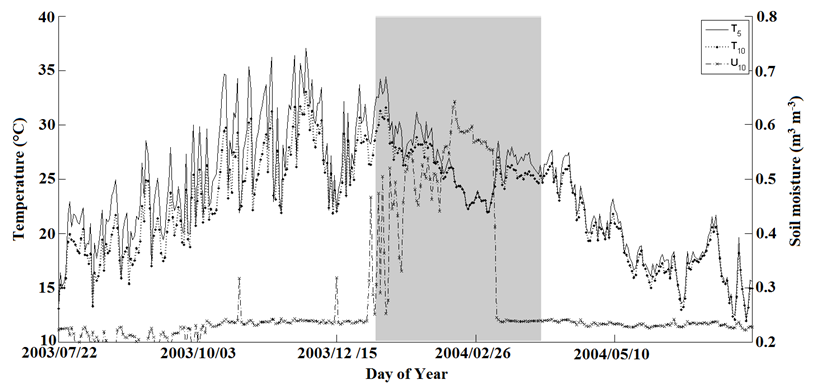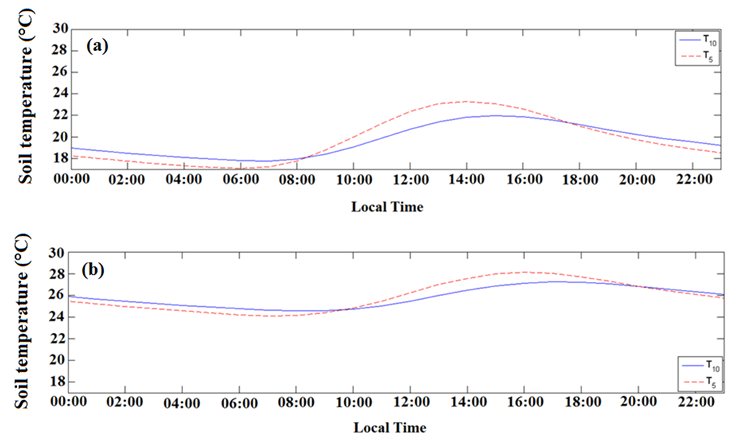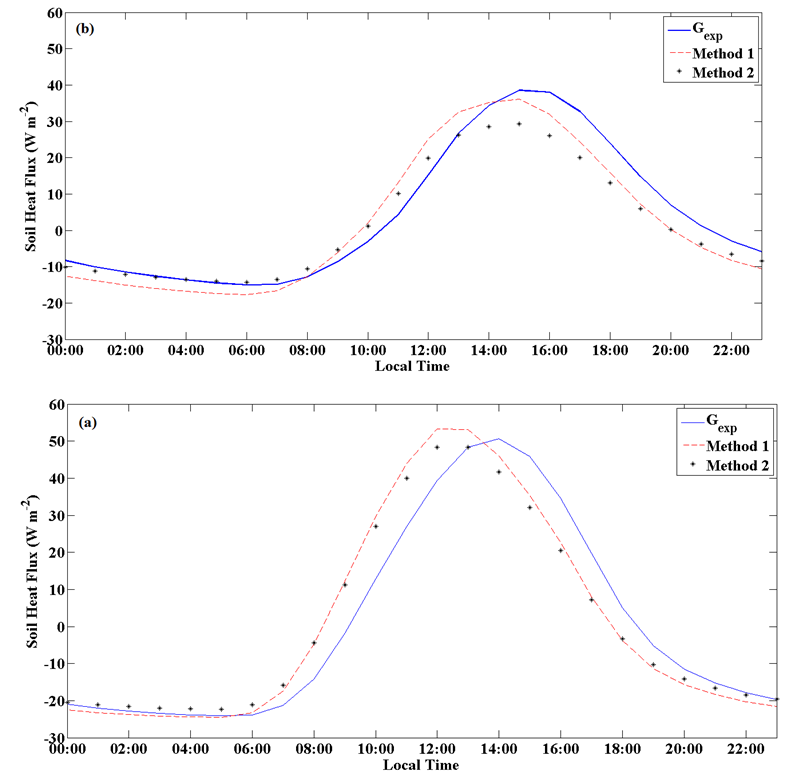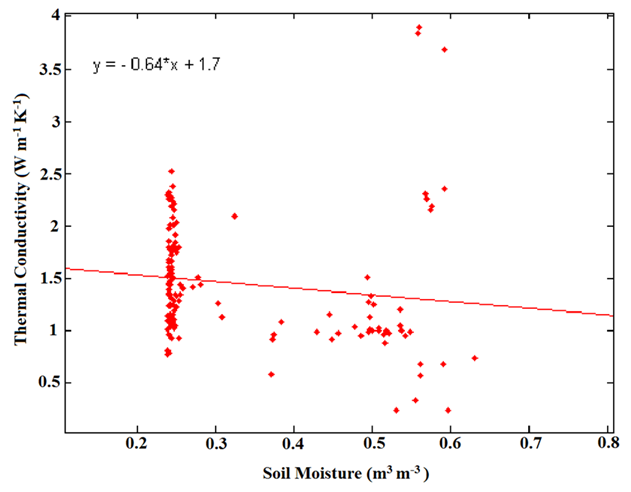-
Paper Information
- Next Paper
- Previous Paper
- Paper Submission
-
Journal Information
- About This Journal
- Editorial Board
- Current Issue
- Archive
- Author Guidelines
- Contact Us
American Journal of Environmental Engineering
p-ISSN: 2166-4633 e-ISSN: 2166-465X
2016; 6(4A): 103-108
doi:10.5923/s.ajee.201601.15

Estimating the Soil Thermal Conductivity Using Experimental Soil Heat Flux in a Rice Paddy Area
Tamíres Zimmer1, Michel Baptistela Stefanello1, Virnei Silva Moreira2, Marcelo Bortoluzzi Diaz1, Vanessa de Arruda Souza3, Débora Regina Roberti1
1Departamento de Física, Universidade Federal de Santa Maria, Santa Maria, Brasil
2Departamento de Engenharia, Universidade Federal do Pampa, Itaqui, Brasil
3Departamento de Geodésia, Universidade Federal do Rio Grande do Sul, Porto Alegre, Brasil
Correspondence to: Tamíres Zimmer, Departamento de Física, Universidade Federal de Santa Maria, Santa Maria, Brasil.
| Email: |  |
Copyright © 2016 Scientific & Academic Publishing. All Rights Reserved.
This work is licensed under the Creative Commons Attribution International License (CC BY).
http://creativecommons.org/licenses/by/4.0/

The soil heat flux (G) is a key parameter for closing energy balance, and a significant variable to understand the surface processes, principally in meteorological applications. Fourier’s Law for heat conduction is a simple methodology to obtain G. In this methodology it is necessary to know the soil thermal conductivity (Ks). In this study, we use the inversion of Fourier’s Law, using experimental values for G and soil temperature in two layers to obtain Ks. The experimental data was measured over a year in a rice paddy area, located in the Paraíso do Sul, southern Brazil. The soil type is Dystrophic Hydromorphic Plainsoil. The Ks were obtained using data of hour 14:00 in two periods: fallow and rice growing season, Ks values were 1.44 and 1.31 W m-1 K-1, respectively. The values of Ks estimated and suggested by literature (for clay soil saturated) were used to estimate G, comparing with G experimental data. The results showed the new values of Ks represent G satisfactory. Since there is no specific Ks in the literature for rice paddy in this soil type, we recommend the application of Ks found in this study.
Keywords: Soil thermal conductivity, Soil heat flux, Rice, Fallow
Cite this paper: Tamíres Zimmer, Michel Baptistela Stefanello, Virnei Silva Moreira, Marcelo Bortoluzzi Diaz, Vanessa de Arruda Souza, Débora Regina Roberti, Estimating the Soil Thermal Conductivity Using Experimental Soil Heat Flux in a Rice Paddy Area, American Journal of Environmental Engineering, Vol. 6 No. 4A, 2016, pp. 103-108. doi: 10.5923/s.ajee.201601.15.
Article Outline
1. Introduction
- Estimating and comprehending the soil thermal properties are important activities in meteorological studies, such as the energy balance closure, weather forecast models and agricultural studies, as well as agricultural production forecast models and soil temperature estimations [1, 2]. The soil thermal properties influence the heat and mass transferring processes between the Earth surface and the soil interior. The soil thermal conductivity (Ks) is a key parameter to the estimation of the soil heat flux (G) [3]. It depends on other soil parameters, such as texture, humidity and soil porosity. However, these parameters can change with the different soil types in a small spatial scale [4], difficulting its precise determination, and the use in meteorological models, for example [5].Currently, several models for the estimations of the thermal soil properties and the soil heat flux have been suggested [6-9]. However, few studies have handled the flooded ecosystems, with a water layer strongly affecting the energy balance components, and thus, the energy transfer to soil as soil heat flux [10-12]. The rice paddy is an example of agroecosystem in which the water needs to be abundant. The flooding affects the soil thermal properties, modifying the energy transferring to the soil. During approximately 80% of the rice growing season, the area stays under a 5 - 10 cm water layer. In this study, the soil thermal conductivity is estimated using the soil temperature and soil heat flux experimentally measured in a rice paddy area, located in a subtropical region in the southern Brazil. The estimation is performed for two distinct periods: rice growing season and fallow. A simplified model for the conductivity using the soil humidity is also suggested.
2. Materials and Methods
2.1. Site Description
- The experimental data used in this study were collected in the period from July 2003 to July 2004. The observations were made in the municipality of Paraíso do Sul (29° 44’ 39,6" S; 53° 8’ 59,8" W; 108 m), in Rio Grande do Sul State, Southern Brazil. The experimental site is flat and homogeneous area, where irrigated rice has been cultivated by flooding since 1980. The soil is classified as Dystrophic Hydromorphic Plainsoil [13], typical from flooded areas for the rice cultivation in this region. The soil is characterized as: sand 23.7%, clay 14.9% and silt 61.4% (for 10cm depth) [14]. The typical weather in the regions is humid subtropical Cfa [15], with ENOS phenomena influence, affecting directly the precipitation, temperature and radiation.About 30 days after the seeding (November 25th 2003) the soil was kept flooded with a water layer of 5 – 10 cm depth, until few days before the harvest (April 4th 2004). It was a rice cycle of 131 days. During the rest of the year the soil was not cultivated, remaining covered with a ground vegetation of spontaneous growing, characterizing a fallow period.
2.2. Experimental Measurements
- The soil temperature and soil heat flux were experimentally measured using the STP01 sensor and Hukseflux sensor (HFP01SC-L), respectively. The soil heat flux was experimentally measured at 7cm depth and the soil temperature at 5cm and 10cm depth.
2.3. Soil Heat Flux Estimation
- The soil heat flux (G) can be estimated using the soil temperature (T) and soil thermal conductivity (Ks) using Fourier’s Law:
 | (1) |
3. Results and Discussions
- Significant changes of soil cover occur between the fallow and the rice paddy period. In the fallow period the soil is covered by harvest cultured residues, or sparse plants, being vulnerable to great daily thermal variations in the 5cm and 10cm deep layers, bringing on differences in the soil temperature up to 5°C between these layers (Figure 1), principally in the end of spring period (november and december). These differences decrease during the rice cultivation. Between January and March, period in which the water layer predominate in the crop (soil humidity greater than 0.4 m3 m-3 in Figure 1), the soil temperatures present even smaller differences between the layers. This is due to the fact that the water layer makes the soil become soaked, modifying its conductivity. After the harvest, when the water layer on the crop vanishes, the temperature differences in both layers are not very accentuated as in the fallow before the planting, mainly because this is the winter season in this region.
 | Figure 1. Daily mean of soil temperature in 5 cm and 10 cm depth. The hatched area in the plot represent the rice growing season |
 | Figure 2. Average daily cycle for soil temperature in 5 cm and 10 cm depth for (a) Fallow and (b) rice paddy period |
|
 | Figure 5. Average daily cycle for experimental G (Gexp) and estimated G using Ks from Method 1 e Method 2 for (a) fallow and (b) rice paddy periods |
 | Figure 6. Soil thermal conductivity versus soil moisture for daily hour of 14:00 |
4. Conclusions
- This study presented an estimation for the soil thermal conductivity value, Ks, for a rice paddy area located in Southern Brazil. The estimated value for Ks for the fallow period was 1.44 W m-1 K-1 and for the rice paddy was 1.31 W m-1 K-1. The soil heat flux estimated using this Ks values satisfactorily represent the experimental soil heat flux values. Since there is no specific Ks in the literature for rice paddy in this soil type, we recommend the application of Ks found in this study.
ACKNOWLEDGEMENTS
- The authors acknowledge the Brazilian agency CNPq, FAPERGS and CAPES for their financial support.
 Abstract
Abstract Reference
Reference Full-Text PDF
Full-Text PDF Full-text HTML
Full-text HTML

